
Afro-Cuban Rhythms For Drumset
.pdf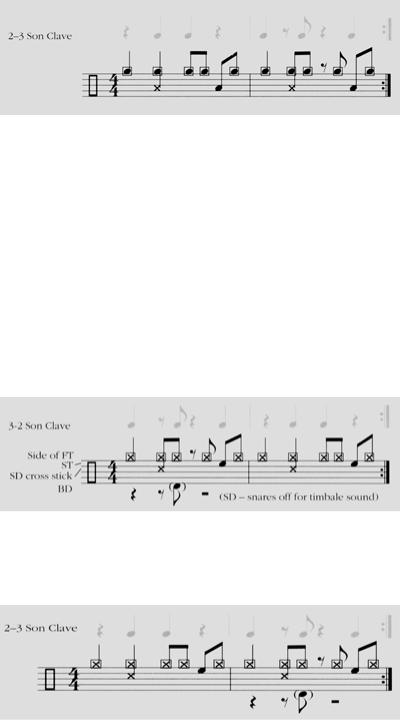
31
And here with 2-3 son clave:
Bombo note:
The second note of 3-2 clave is called the bombo note because the bombo drum played in the conga rhythm accents this note of the clave. The bombo note is accented in folkloric music (congas, rumbas, etc.) as well as the popular dance music styles (son music, mambos, etc.) In the bombo drum pattern all notes are muffled except the bombo note.
Let's try the cascara pattern with the bombo note played with the bass drum:
And again with 2-3 clave:
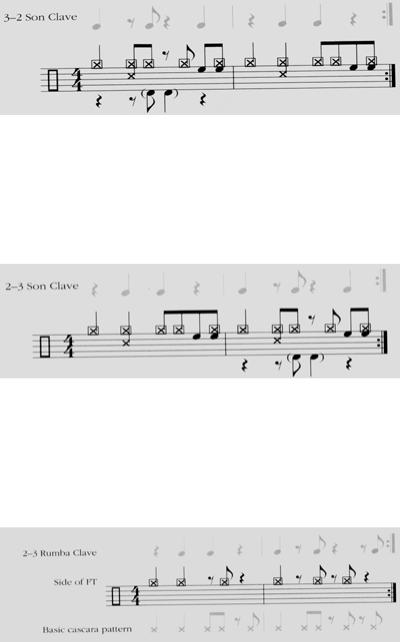
32
When playing without a conga player you can add an extra tom note on the "and" of "4" imitating the tumbao pattern. Hear:
The bass drum can imitate the lower conga drum by playing two notes on the three part of the clave which answers the tumbao figure played on the higher conga. Let's try the same pattern played to 2-3 son clave:
Here's a syncopated cascara variation which is played in Cuba. This pattern uses only certain notes of the basic cascara pattern. Some bands in Cuba, such as Los Van Van, use this cascara variation. Syncopated cascara:
Since the hi-hat is not part of the timbale set-up, it is of course not usually heard in Afro-Cuban music. Playing the hi-hat also tends to interrupt the syncopated flow of the cascara patterns. However, as a great independence exercise you could try playing the clave pattern with your left foot on the hi-hat. In fact, you can try playing clave with the hi-hat in many of the different sections of this site. But remember, the hi-hat is not a traditional sound in Afro-Cuban music, it is used more in African popular music, Calypso, Reggae, Brazilian music, jazz and rhythm and blues. The hi-hat can be played with the 6/8 feel, mozambique and songo, not in their traditional forms but more in the styles of funk and fusion.
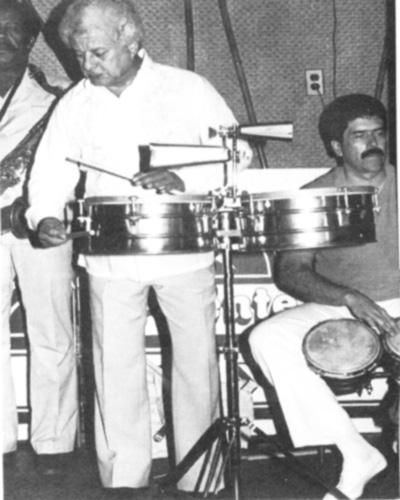
33
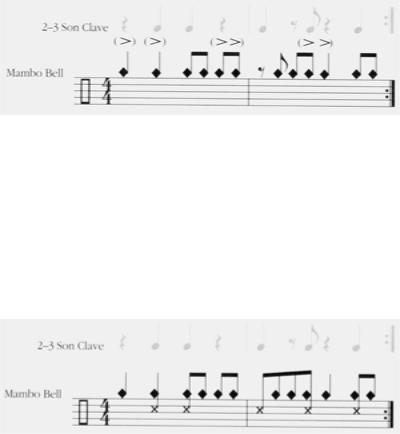
34
CHAPTER 4
Bell Patterns:
The timbale set-up includes a mambo bell which is a long, wide, lowpitched bell, and a cha cha bell a small high-pitched bell. The mambo bell is used in many of the dance feels based on son music, especially mambo, which was made popular in Cuba in the late 1930's. The cha cha bell is used mostly in cha-cha-cha, which was a dance created by charanga orchestras in the 1950's.
Mambo Bell Patterns:
In softer sections of dance music the cascara pattern is played on the side of the timbales. During louder sections the mambo bell is played. We will hear how both patterns work in the popular dance music based on son which includes mambo, and the New York style called salsa. The mambo bell is mounted on the timbales so that it lies perpendicular to the player. Played with timbale sticks, the stick strikes across the middle of the bell.
The most common mambo bell figure sounds like this:
We have written the accented notes in parentheses because although the notes are accented it is important not to over accent them. We'll only write in the accents one time for the 2-3 and 3-2 patterns, but remember the accents are part of the mambo bell patterns. The son clave is the clave heard most often with mambo bell patterns. Notice how the mambo bell pattern synchronizes with the 2-part of the clave. This can be helpful in finding the clave pattern. Let's play the 2-3 son clave with a snare drum cross stick.
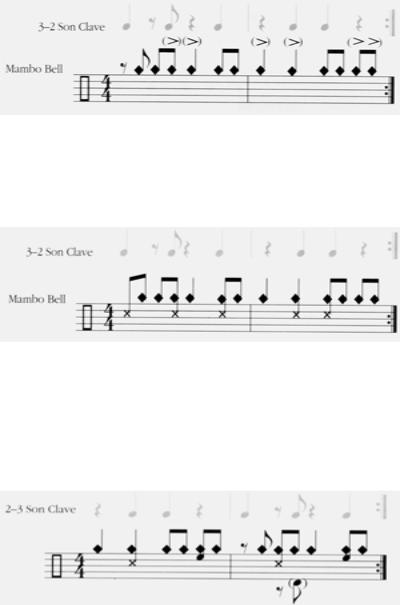
35
It is difficult to place a cowbell on the drumset at the same angle used in the timbale set-up. Most cowbells that are mounted on the bass drum have the mouth of the bell pointing towards you. This will work fine, just play the patterns on the middle part of the bell, preferably with the butt end of the stick for a fuller sound. Let's try the mambo bell pattern played 3-2:
Now let's add the clave rhythm with the left hand. Notice the silent "1" in the bell part and how it relates to the clave:
Returning to the 2-3 pattern, with the left hand play a snare drum cross stick on "2", and a small tom on "4". The right hand plays the mambo bell pattern. This is what a timbalero would play, except that he would muffle beat 2 with the left hand instead of playing the rim. Mambo bell pattern 2-3, with a conga player:
As we saw before, when playing cascara on drumset with a conga player the bass drum can play the bombo note. Because this rhythm is derived from a timbale pattern, the hi-hat will not be used. Playing "2" and "4" on the hi-hat can sometimes work if you think of it as part of the guiro rhythm and not as backbeats. Again, listening to recording and live performances will help you learn the right phrasing. When playing without a conga player, you can play the conga part on the small tom. The bass drum can play the notes shown in the second measure imitating the lower conga part.
Let's try the mambo bell pattern (2-3) without a conga player:
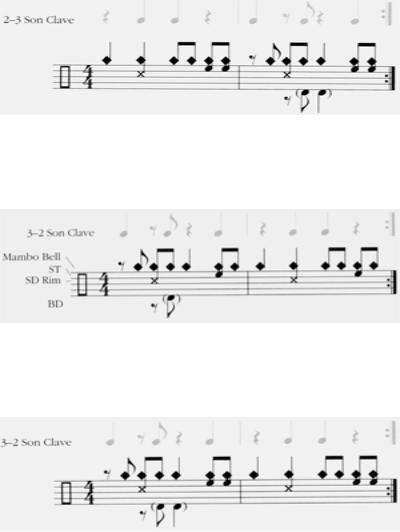
36
Now we will hear the same patterns played to 3-2 clave:
If there is no conga player, you can play the conga part on the small tom:
Here are some other mambo bell patterns that can be played as variations for mambo and related dance feels. These patterns can be played 3-2 or 2-3. Many of these patterns work well for conga, bongo or instrumental solos.
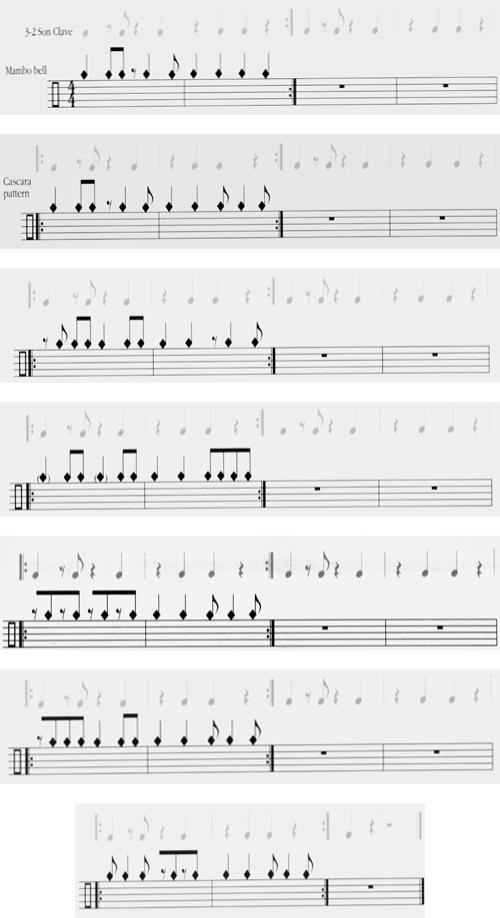
37
Mambo bell variations:

38
Bongo Bell Patterns:
As well as playing bongos, the bongocero plays a cowbell called campana or bongo bell. This cowbell has a wider, thicker bell with a "fatter" lower sound. Played with a short, round piece of wood, the mouth and middle of the bell are played, producing two different sounds. The bongo bell is played in certain sections of son style dance music, along with the mambo bell. The bongo bell pattern adds drive to the rhythm and plays an important role in emphasizing the downbeat (played on the mouth of the bell). The basic bongo bell pattern is as follows:
Notice that on the 2-part of the clave only one note is played on the middle of the bell. This is your key to where the 2-part of the clave falls. This pattern can be played 3-2 by reversing the figure. Here:
Now we will play the bongo bell pattern on a mounted bell with the right hand and add the son clave with snare drum cross stick. We will use both 2-3 and 3-2 son clave:
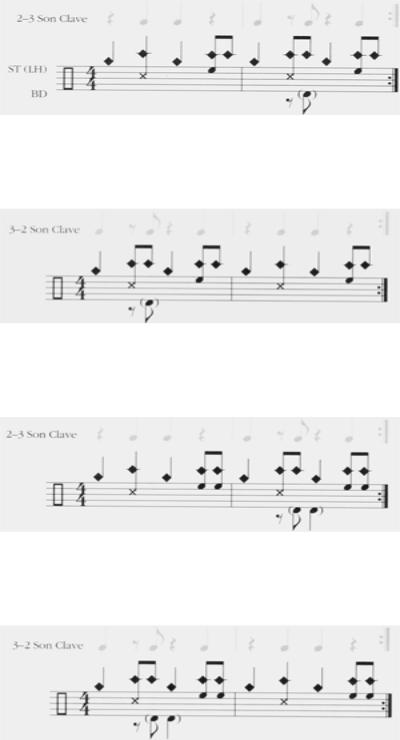
39
Bongo bell patterns with a conga player
You can play this pattern with the basic left hand timbale pattern that we used before with cascara and the mambo bell pattern.
Bongo bell pattern with a conga player(2-3 son clave):
Bongo bell pattern with a conga player (3-2 son clave):
Bongo bell pattern without a conga player (2-3 son clave):
Bongo bell pattern without a conga player (3-2 son clave):
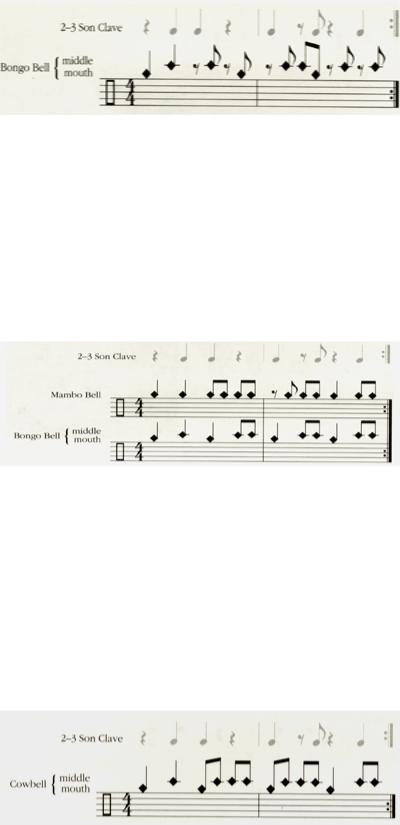
40
Bongo bell variation:
This bell variation or the cascara pattern (on the middle part of the bell) are often played during timbale or conga solos.
Mambo bell and Bongo bell patterns together:
Here's what the two bell patterns sound like played together. Notice where the patterns overlap and how they both fall on the clave. Listen for the 2-part of the clave where both patterns meet with the clave:
Ideas:
You can try playing both patterns on two bells to build independence. The higher-pitched, thinner-sounding bell can play the mambo bell pattern while the lower-pitched, fatter-sounding bell plays the bongo bell pattern. You can try playing both bell parts on one bell. Certain cowbells have a wide mouth and a clear high-pitched body which allows you to play a combination of the two parts. On a mambo or bongo bell, playing both parts doesn't sound right. The mouth of the mambo bell is too thin and the body of the bongo bell is too low-sounding.
Here's a pattern which includes both mambo and bongo bell parts:
This is basically what one hears when both bells are played. This combination can get "busy" and works better at slower tempos.
